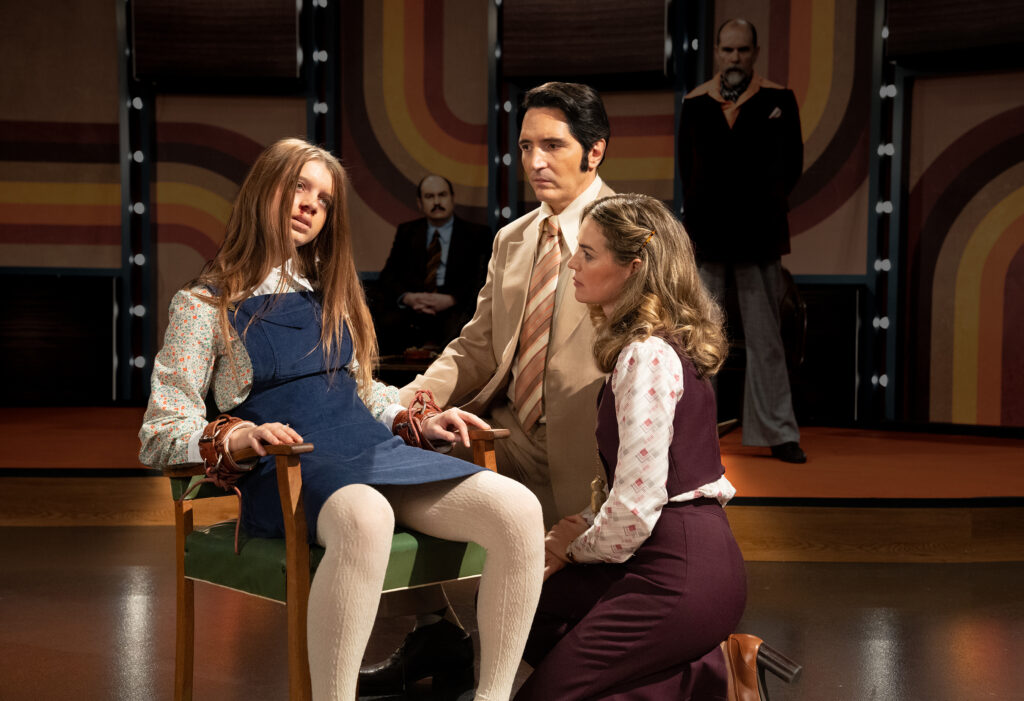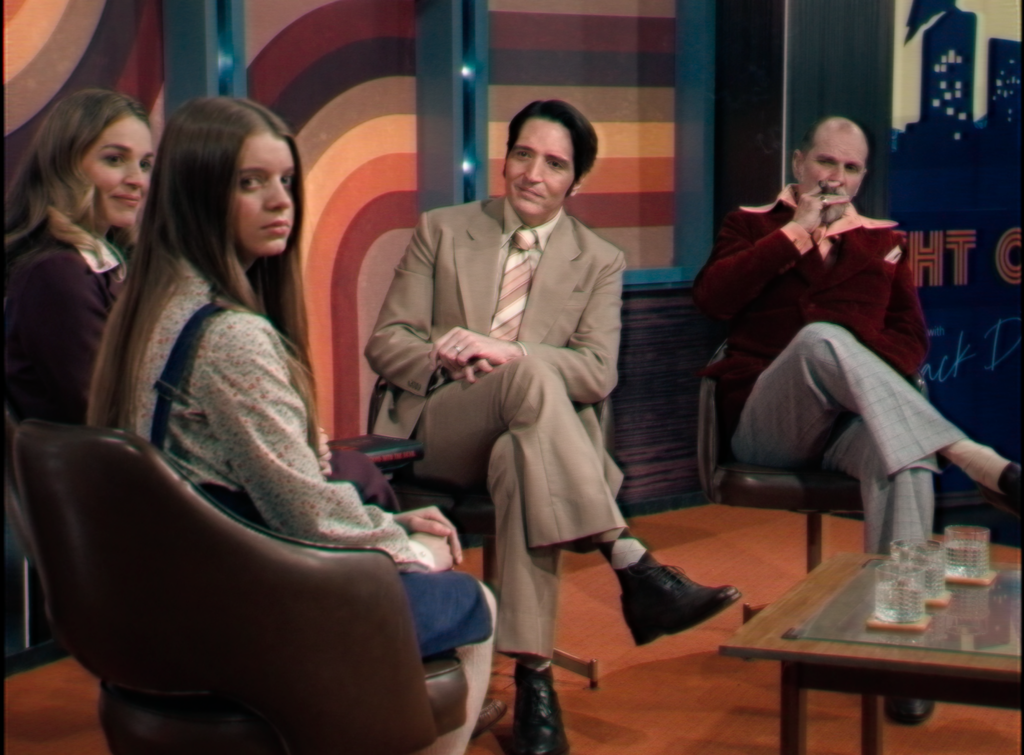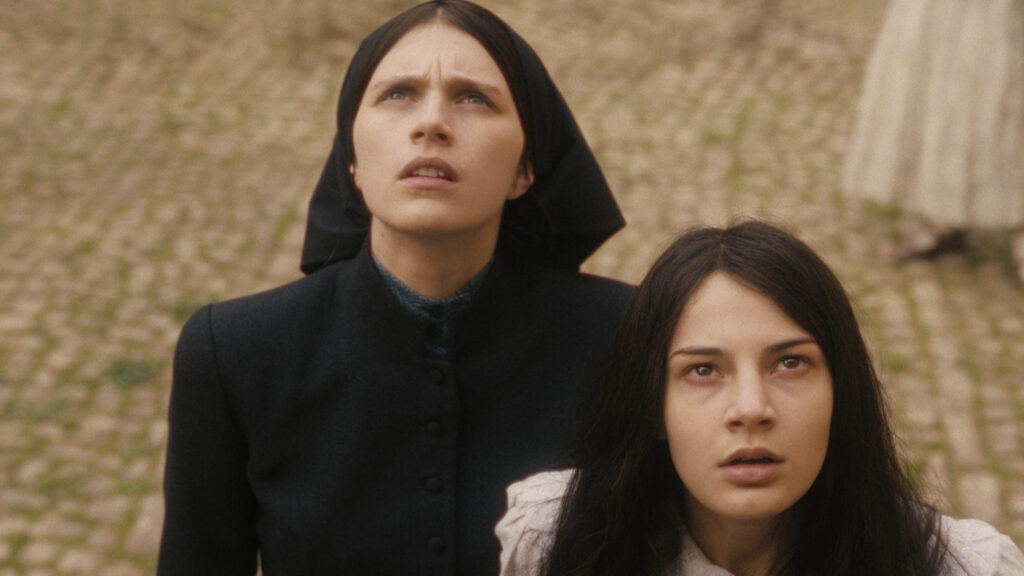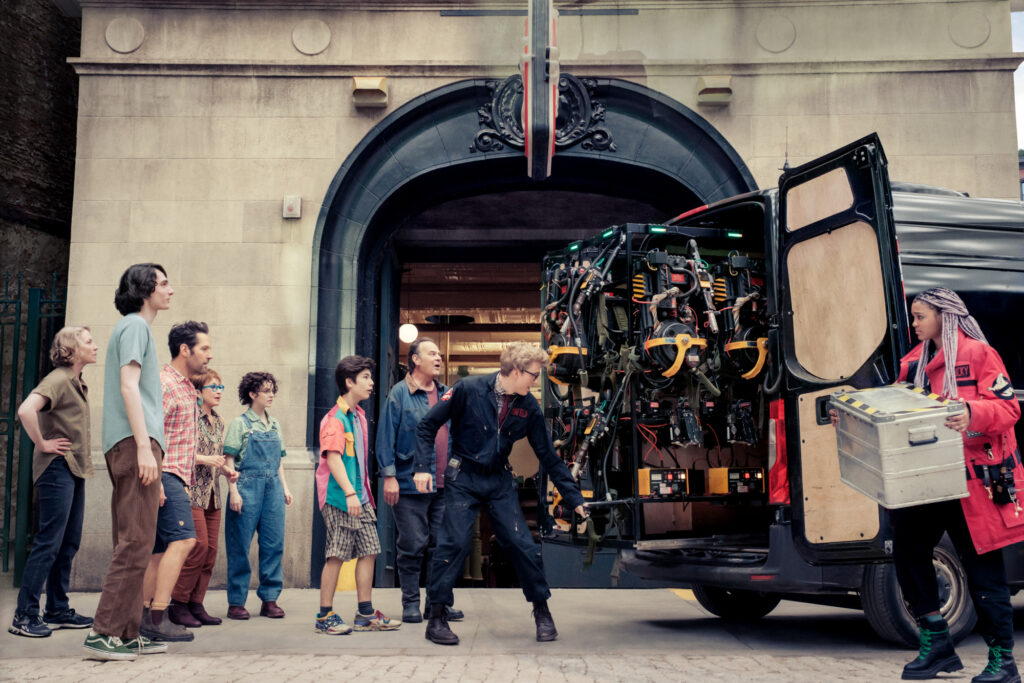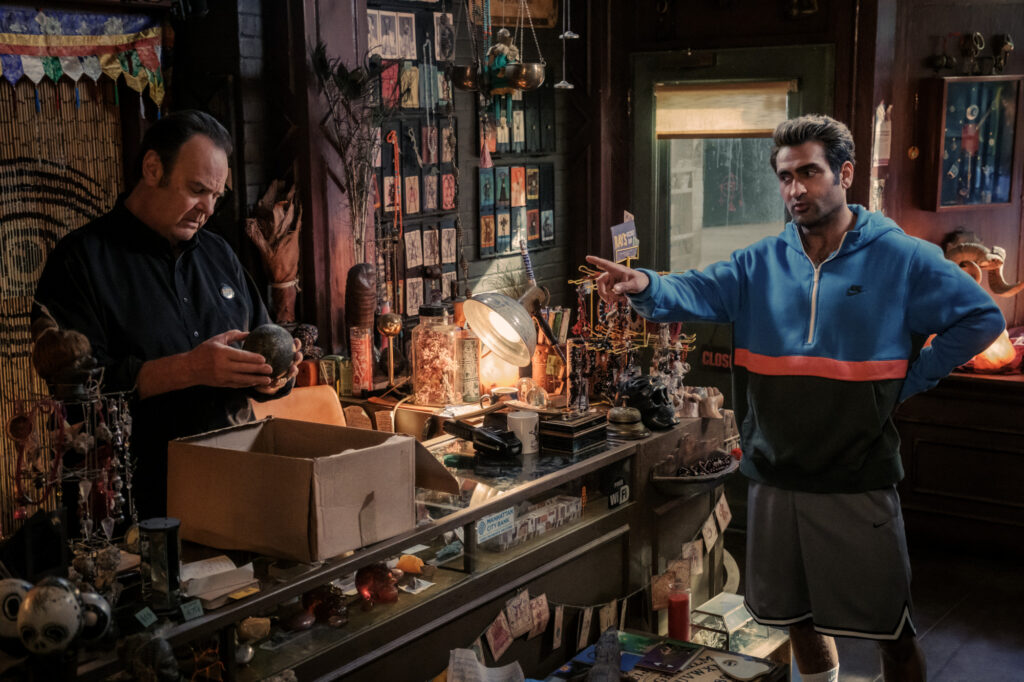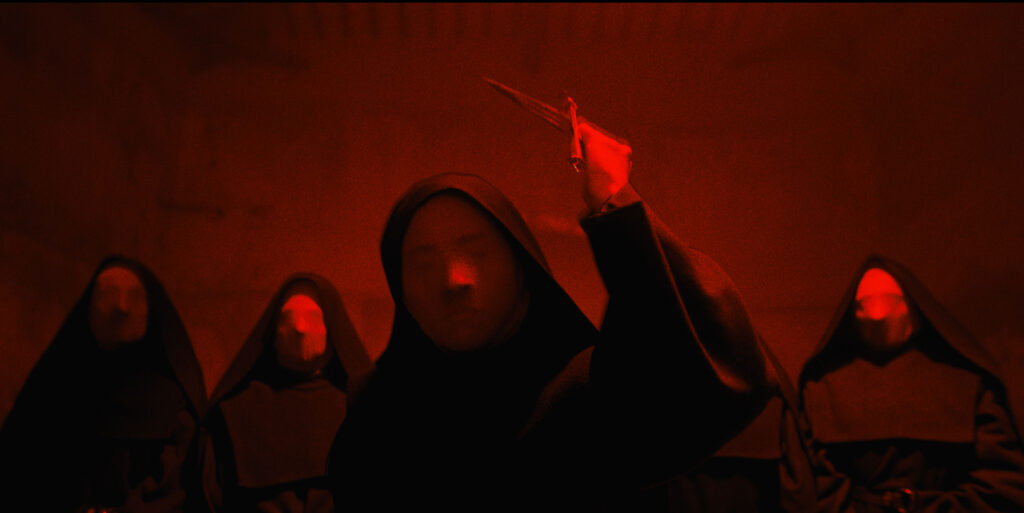April 18, 2024
by Carla Hay
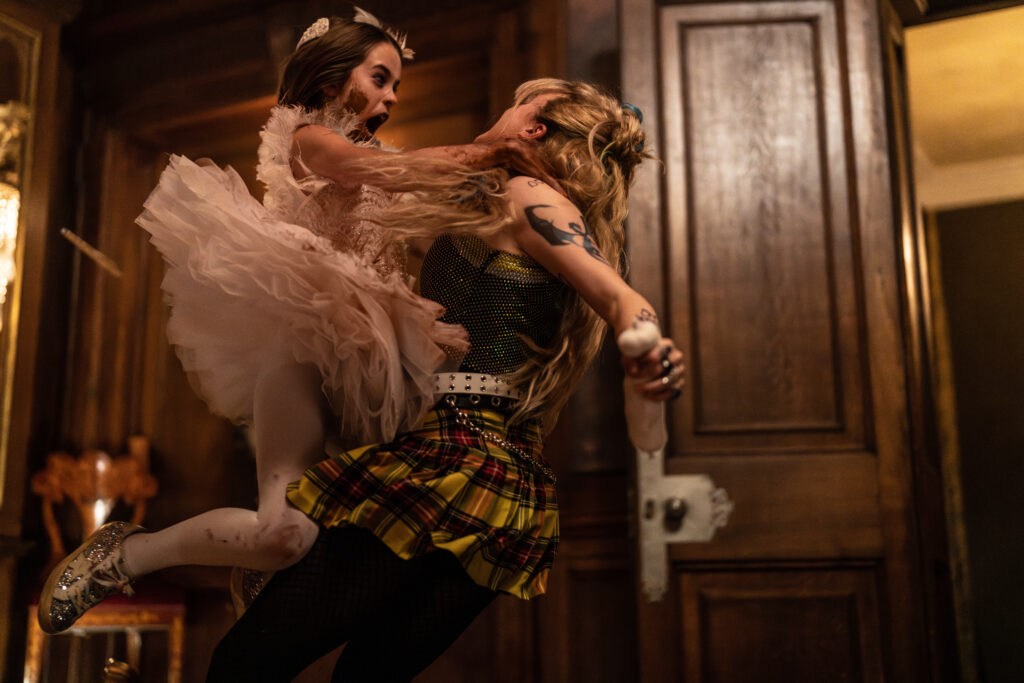
Directed by Matt Bettinelli-Olpin and Tyler Gillett
Culture Representation: Taking place in an unnamed U.S. state, the horror film “Abigail” (a reboot of the 1936 film “Dracula’s Daughter”) features a predominantly white cast of characters (with a few African Americans and one Latina) representing the working-class, middle-class and wealthy.
Culture Clash: Six kidnappers take a 13-year-old rich girl for ransom, only to find out that she is vampire, and they are trapped in the mansion where they are holding her captive.
Culture Audience: “Abigail” will appeal primarily to people who are fans of the movie’s headliners and gory horror movies that skillfully blend scares with comedy.

The vampire kidnapping flick “Abigail” is a wickedly funny horror romp that is best enjoyed by people who have a high tolerance for bloody gore on screen. The movie builds suspense on which alliances will survive and which will fall apart. It’s a movie that doesn’t take itself too seriously, but there are some poignant moments that bring a certain level of gravitas to a movie that delivers laughs along with the scares.
Written and directed by Matt Bettinelli-Olpin and Tyler Gillett, “Abigail” is a reboot of sorts of the 1936 horror movie “Dracula’s Daughter.” Bettinelli-Olpin and Gillett (who are members of the filmmaking collective nicknamed Radio Silence) continue their pattern of making horror films that are filled with sarcastic jokes and have some characters who aren’t what they initially appear to be. Bettinelli-Olpin’s and Gillett’s previous films include 2022’s “Scream” and 2023’s “Scream VI.”
In “Abigail,” the title character is a girl who appears to be 12 years old, but she’s really a vampire who is hundreds of years old. This isn’t spoiler information because Abigail being a vampire was already revealed in the movie’s trailers. Abigail (played by Alisha Weir) is a master manipulator who puts her wits and superhuman powers to use when she is kidnapped by a motley crew of criminals who demand a ransom of $50 million.
In the beginning of “Abigail,” she is shown dancing on stage in a ballerina costume to “Swan Lake” in an empty auditorium. (“Abilgail” takes place in an unnamed U.S. state but was actually filmed in Ireland.) After this rehearsal is over, Abigail goes into a chauffeur-driven car. Unbeknownst to the driver, the car has a tracking device placed on it by six criminals, who have been lying in wait to kidnap Abigail in a van that is labeled as a Flush Force plumbing company van.
The abductors follow the car to Abigail’s mansion, where she is home alone. Abigail is quickly abducted: She’s drugged using a hypodermic needle, blindfolded, and put in a body bag. The kidnappers make their getaway within a minute after some people arrive at the home and see that there’s been a break-in and Abigail is missing. The kidnappers then drive to another mansion in a remote area, where they meet with their no-nonsense supervisor named Lambert (played by Giancarlo Esposito), who praises them for completing their mission. Lambert then says he’s leaving them to look after Abigail until they get the ransom money.
Conversations in the movie reveal that Lambert assembled this kidnapping crew and deliberately selected people who are strangers to each other. They are under strict orders to not tell each other their real names or any personal information about themselves. Lambert assigns aliases to all of the kidnappers and takes their cell phones before he leaves. The kidnappers are also under orders to wear masks at all times when they are around Abigail, who is not always blindfolded. Lambert tells the kidnappers that they are better off not knowing who Abigail’s family is.
The six kidnappers who are in the mansion with Abigail are:
- Frank (played by Dan Stevens), a bossy and arrogant know-it-all, who appoints himself the leader of the six kidnappers who are left behind in the mansion.
- Joey (played by Melissa Barrera), a street-smart go-getter, who has been tasked with being the one to interact with Abigail in the room where Abigail is handcuffed. It’s later revealed that Joey has a young son, which is why she was assigned caregiver duties for Abigail. (Joey having a son is information that is also in the movie’s trailers.)
- Rickles (played by Will Catlett), an expert sniper who has a mutual attraction to Joey.
- Sammy (played by Kathryn Newton), a skilled computer hacker who looks like a party girl but who can strongly defend herself when necessary.
- Dean (played by Angus Cloud), a stoner who tries and fails to get Sammy to be romantically interested in him.
- Peter (played by Kevin Durand), a dimwitted muscle man who has the most physical strength in the group.
Joey is very good at reading people and quickly tells the other members of the group that she has figured out certain things about them, which they do not deny. Joey deduces that Frank used to be a police detective. Rickles was in the U.S. military, most likely the U.S. Marines. Sammy is a spoiled rich kid who commits crimes for the thrills.
Dean is a “sociopath,” according to Joey. Peter used to be bullied as a kid and built his muscular physique as a way to intimidate people and to defend himself from being physically bullied. As for Joey, Frank quickly figures out that she is a needle-using drug addict who appears to be in recovery.
The six kidnappers have been promised $7 million each as their cut of the ransom. They assume that Lambert will get the remaining $8 million, since he’s the supervisor who brought them together and told them what to do. Despite being told that they aren’t supposed to know who Abigail’s family is, the kidnappers get curious.
The only thing that Lambert has told the kidnappers about Abgail’s family is that Abigail has a very wealthy father who is expected to pay the ransom. There is no mention of Abigail’s mother. Eventually, the kidnappers find out that Abigail’s father is Kristof Lazar (played by Matthew Goode, in a very small role), who has a certain sinister reputation that is detailed in the movie.
A series of events reveal Abigail to be a vampire, and the kidnappers are locked and trapped inside the mansion. That’s when movie kicks into high-gear horror, as it turns into an all-out war between Abigail and the kidnappers. However, this war is not as simple as it seems, because Joey made a promise to never hurt Abigail before Joey knew that Abigail was a vampire. Will Joey keep this promise? Who will die and who will survive?
As the wily vampire Abigail, Weir gives a very talented performance as a child who shows vulnerability and viciousness. There’s more than a ring of truth when Abigail confides in Joey that Abigail feels lonely and neglected because her father thought he wanted a child but has apparently changed his mind. This backstory for Abigail makes her a little more complex than the typical horror movie villain.
Even though egotistical Frank would like to think he’s the leader of this doomed group, Joey is really the one who comes up with the best ideas. Barrera (who previously worked with Bettinelli-Olpin and Gillett in “Scream” and “Scream VI”) does a capably effective performance as Joey, who has plenty of secrets. It’s eventually revealed that these kidnappers have more in common that just abducting Abigail.
All of the other cast members play their roles well with the right touches of comedy. (The movie’s closing credits have a tribute to Cloud, who died of a drug overdose in 2023. He was 25.) Cloud’s befuddled Dean character is intentionally the movie’s biggest comic relief.
There are a few twists and turns in the movie’s plot. Just when it looks like “Abigail” is going to end, something happens that continues the story. Some viewers might not like how the movie prolongs the story with this twist, while others will enjoy this unexpected turn of events. A horror movie about a killer kid could have turned out wrong in so many ways, but “Abigail” is like a bloodier, longer and more gruesome version of an entertaining horror ride at an amusement park.
Universal Pictures will release “Abigail” in U.S. cinemas on April 19, 2024.

